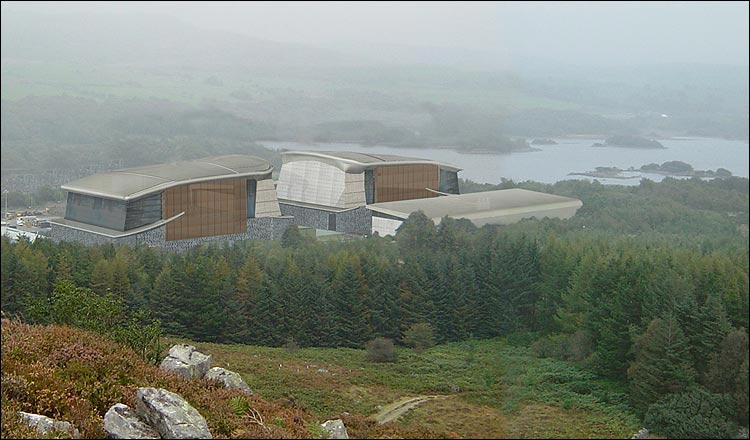Decommissioning
Britain's 19 former power stations is likely to cost £73bn, rather
than the estimated £63bn, a new National Audit Office report has
found.

This is how Trawsfynydd could eventually look in the future,
according to this artist's impression.
BBC Wales Sustainability Correspondent Iolo
ap Dafydd visited a new nuclear storage site at the former Trawsfynydd
nuclear power plant. Hidden behind the two hulking 70m (230ft) high old
reactors at the Trawsfynydd site, is a brand new building.
Later this year it will used to store concrete
crates of intermediate nuclear waste from when electricity was produced
at the former atomic power station. Up to 360 such crates,
weighing up to 42 tonnes can be stored there.
On the other side of this expensive nuclear
warehouse, there will be room for 2,400 drums of resin waste which was
contaminated in the cooling process of producing power.
Since 1993 the decommissioning work at the
site has continued.
The 45-acre area won't be totally cleaned
until 2098.
The contractors, Magnox North who carry out
the clean-up for the Nuclear Decommissioning Authority (NDA), used 30 tonnes
of reinforced concrete, and dug down to the bedrock to secure the storage's
foundation.
Simon Lewis, the senior project manager on
site, said: "The facility itself is incredibly safe. It's...a very,
very large concrete structure, the walls are between 2ft - 3ft thick. We've
put something like 30,000 tonnes of reinforced concrete in here. It's incredibly
safe. It's gone through an enormous amount of stringent design, it complies
with all the legislation that's required. It's designed to last up to 150
years." |
Right in the middle of the Snowdonia National
Park, the storage design had to conform to its environment. Severe weather
and a higher than average rainfall are other considerations.
Other nuclear waste storage units are being
built elsewhere in Britain, but this one at Trawsfynydd will be the first
to actually receive and store local waste.
Almost the size of a football field - 92m
(302ft) long and almost 30m (98ft) high, all of the former nuclear power's
intermediate and low-level radioactive waste can be stored here for up
to 40 years.
Or at least until a national nuclear repository
centre can be found, and then be prepared to store all of Britain's dangerous
waste.
Hywel Madog Jones who has worked at the Trawsfynydd
site since the 1970s, is the site's safety case officer.
"In order to build this building, we went
through a public inquiry and one of the planning conditions we have on
this store is that we're not allowed to import waste from other sites.
It's for use for Trawsfynydd waste only
and that's a legal condition."
Earlier this week, the actual costs of nuclear
decommissioning were highlighted in the National Audit Office report to
the NDA.
With costs between 2005 and 2007 estimated
costs will be £12bn pounds higher than expected. In the
audit office report, the Trawsfynydd site's decommissioning costs are 23%
higher and the final clean-up bill will be closer to £1.5bn. Haf
Elgar works for Friends of the Earth Cymru. Asked about the £12bn
rise identified in the report, she said: "The cost was high in the first
place, and has risen each year. believe that this shows that we do
not know what the future holds. It is going to take years to deal with
nuclear waste."
The consultation for new nuclear power stations
has already been announced by the Business Secretary John Hutton, as one
proposal of producing enough power for Britain in the next 10 to 20 years,
in a clean and carbon-free way. |